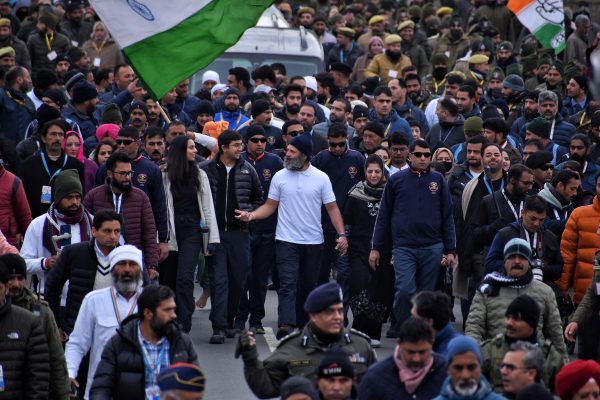
Rahul Gandhi’s 4,000-kilometer Bharat Jodo Yatra – Unite India March – came to an end when the Indian politician unfurled the tricolor at Lal Chowk in Srinagar, Kashmir, on January 30.
The aim of this yatra, which was organized by the Indian National Congress, was to bring India together and strengthen the nation. The yatra began on September 7 in Kanyakumari in the state of Tamil Nadu. Congress supporters then traveled through 12 states, covering nearly approximately 4,000 kilometers in 150 days.
Rahul Gandhi, the former Congress president, was among the 119 leaders who participated in the party’s largest public contact campaign in recent memory.
India has a storied history of long walks and rallies by different political leaders in support of social, political, and economic causes. The Bharat Jodo Yatra has been compared to those other occasions and dubbed by many a turning point in modern Indian politics.
Gandhi’s leadership abilities and capacity to connect with a wide range of the populace have changed significantly as a result of the yatra. He has been successful in dispelling the stereotype of the current ruling elite, which painted him as an inexperienced politician or a rich prince who was disconnected from everyday life.
The yatra has recast Gandhi as a new mass leader. He even declared that he had killed the old Rahul Gandhi and had emerged as a new person. It is only natural for the ruling Bharatiya Janata Party (BJP) to be concerned about the reconstituted and improved Rahul Gandhi 2.0.
After passing through the nine-kilometer-long Banihal tunnel, Gandhi continued his padayatra in the Kashmir Valley amid sub-zero temperatures with strict security protocols.
In the first major political activity in the region since the abrogation of Jammu and Kashmir’s special status in 2019, thousands of people welcomed Gandhi for the march’s conclusion.
To welcome Gandhi, who highlighted his Kashmiri “roots,” Dr. Farooq Abdullah, a former chief minister of Jammu and Kashmir, traveled 350 kilometers from Srinagar to Lakhanpur. Abdullah compared Rahul’s journey from Kanyakumari to Kashmir to the one undertaken by the vedic scholar Shankaracharya in the eighth century.
On January 27, another former Jammu and Kashmir chief minister, Omar Abdullah, marched alongside Gandhi in the Banihal area of the Ramban district of the Union territory.
Gandhi was joined by a third ex-chief minister, Mehbooba Mufti, along with her mother and her daughter Iltija Mufti as the walk resumed from Awantipora’s Chersoo village in the morning. Priyanka Gandhi Vadra, the Congress general secretary, also joined her brother on the final leg of the yatra in Kashmir.
On January 29, Rahul Gandhi took a 30-minute break from the foot march in Sonawar to visit Jammu and Kashmir Pradesh Congress Committee headquarters at Maulana Azad Road before proceeding to Srinagar’s clock tower, also known as Ghanta Ghar.
Jairam Ramesh, general secretary of the All India Congress Committee in charge of communications, stated on Twitter that the flag unfurling was scheduled for Monday, but had to be done a day earlier.
During the event, barricades and concertina wires were installed at all entry points, and security personnel were heavily deployed. Shops, businesses, and the weekly flea market were all closed as part of the security drill for the flag-raising ceremony.
According to Gandhi, who spoke at a press conference in Srinagar, statehood for Jammu and Kashmir and restoration of democratic processes are a necessary and crucial first step. In response to a question about holding talks with Pakistan, he said, “The other measures will come later, and I do not necessarily have to remark on them now.”
“Each state has its own legislature. The people of Jammu and Kashmir have a right to a democratic process, which should be restored. Ladakhis should also be given a solution “ he added.
The former state of Jammu and Kashmir was split into two separate union territories – Jammu and Kashmir, and Ladakh – in August 2019 by the ruling BJP. Immediately after, a crackdown in the territory saw many political leaders detained.
Opposition leaders also joined Gandhi as he marked the end of the Bharat Jodo Yatra. The event was attended by leaders from the Dravida Munnetra Kazhagam, National Conference, Peoples Democratic Party, Communist Party of India, Revolutionary Socialist Party, and Indian Union Muslim League. For the first time, leaders from many political parties from across the country shared the stage in Srinagar for the event, which coincided with Mahatma Gandhi’s death anniversary.
The event was attended by all of the Congress party’s MPs, members of the Congress Working Committee, and state presidents.
Attendance was especially impressive considering that, due to heavy rain and snowfall in the area, most Srinagar-bound flights had been cancelled for the day. Former Karnataka Chief Minister Siddaramaiah’s trip from Delhi to Srinagar to participate in the rally was cancelled, for example.
Kashmir Welcomes Rahul Gandhi and His Bharat Jodo Yatra
Source: Frappler

0 Comments